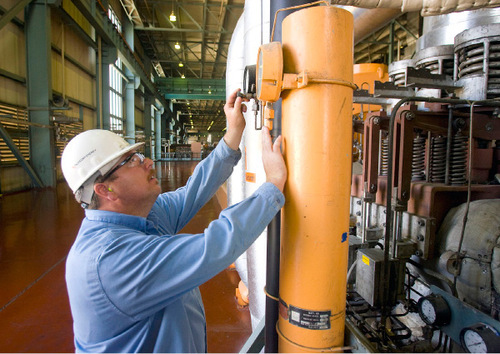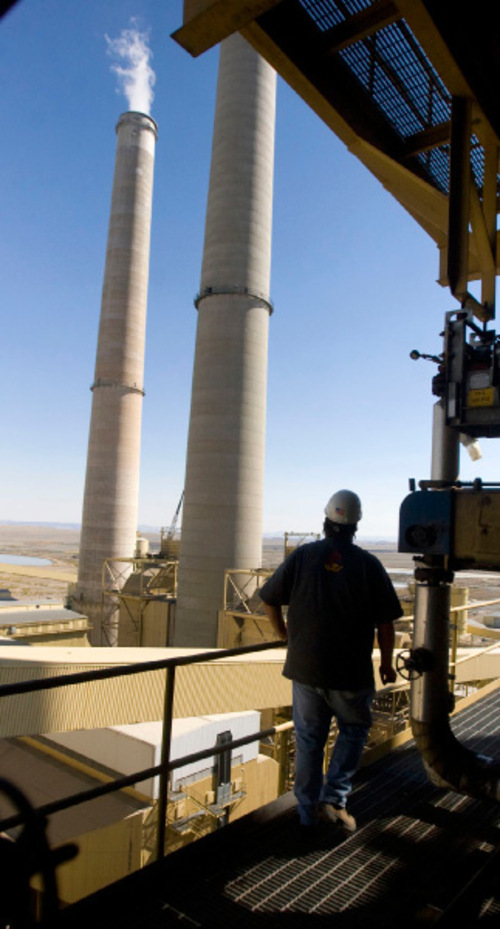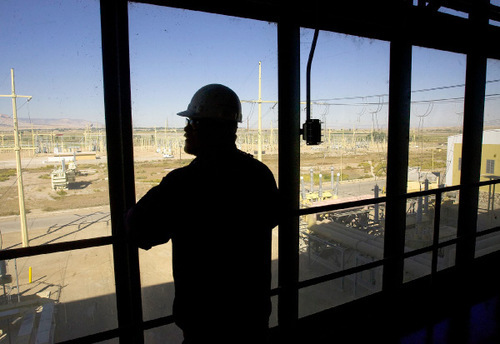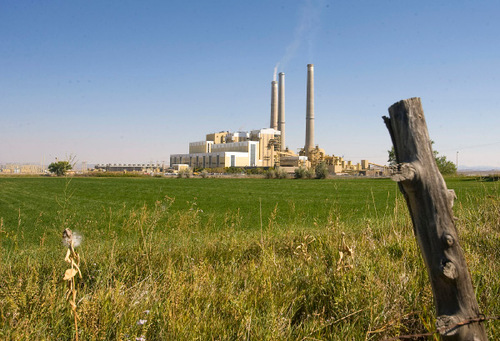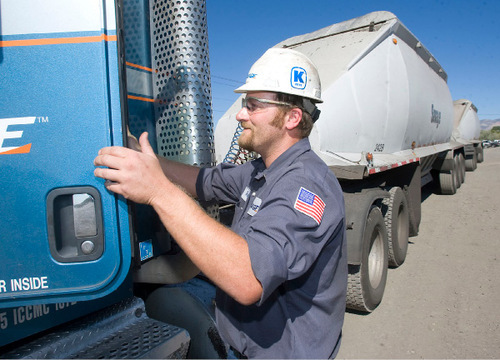This is an archived article that was published on sltrib.com in 2010, and information in the article may be outdated. It is provided only for personal research purposes and may not be reprinted.
Castle Dale • A relentless demand for electricity has kept the economies of Emery and Carbon counties humming through the Great Recession.
Not that there haven't been plenty of personal and commercial brownouts in the past couple of years. At the food banks Jackie Butkovich runs in Price and Castle Dale, the number of families being served was 83 percent higher last month than in September 2008. Some businesses did not survive.
But the drain on her limited resources could have been much worse if it were not for the stabilizing force provided by the high-paying jobs involved in generating electricity at PacifiCorp's three coal-fired power plants — Hunter 1 in Castle Dale, Huntington outside the Emery County town of the same name, and the Carbon plant near Helper.
Hundreds work directly at the plants or on power lines emanating from them. Hundreds more work in the coal mines that supply the fossil fuel that turns the turbines to make the electricity. Scores of truck drivers are employed moving cut coal from mines to PacifiCorp's plants or to rail lines where it will be hauled to other utilities. Service companies abound that provide the labor and supplies needed to keep mining equipment, big rigs and giant electrical motors and fans running smoothly.
"If you are from Carbon or Emery, everything we do here revolves around energy," said Gary Haeck, 40, of Price, supervisor of inside maintenance at the Hunter plant. "Take the plants away and everything goes. These little towns wouldn't have anything."
Instead, with its two coal-fired plants being mainstays since the mid-1970s, and dozens of consultants now studying the possibility of building a nuclear-powered plant near Green River, Emery County is one of Utah's only counties to show job growth this year (4.1 percent from March 2009 to March 2010).
Even in 2009, when the recession was at its worst nationally, Emery County's job loss percentage was just 2.2 percent, fifth best in the state. Carbon County was better statistically, falling 1.1 percent (third best) from the previous year. But Carbon experienced a number of layoffs late in the year, and 2010 has continued that trend, said John Krantz, a regional economist with the Utah Department of Workforce Services.
—
A good transition • The latter still does not diminish the fact that the utilities industry provides both counties with economic stability. Krantz noted in a June report that the average annual wages for utility workers in Emery County was $88,000, compared with the county average of $37,500. The disparity in Carbon County was $74,600 for utility workers to $36,000 overall.
Also helping, said Emery County economic development director Mike McCandless, is that the work force at his county's power plants is going through a transition. The people who built the plants and have operated them since are heading into retirement. So although the power plants are not adding employees, high-paying positions are opening up for younger people such as Haeck.
"That's our hidden secret," said McCandless. "As many as 75 percent of the power plant workers and miners will retire in the next five years. Those folks don't leave when they retire. They will stay here and spend their money. And they will be replaced [at the plants] by someone new who will be taking a high-paying job."
Haeck fits that description. He had worked for nine years as a contractor with Power Source Services out of Castle Dale. But last December, the maintenance supervisor job became available. He was attracted to it by the predictable hours it offers, freeing him to pursue his real passions — coaching daughter Paige's fastpitch softball team and watching son Garret play sports.
"When you're a contractor, you can't do that. I'm home pretty regularly now," he said.
A couple of electricians he works with — Brett West, 40, of Ferron, and Ryan Jensen, 32, of Elmo — also were enticed into moving back to Emery County from Pleasant Grove north of Provo in recent years by the power plant jobs.
"I realized I could bring my family down, live in a place that's out of the city, have a decent job and be able to afford it," said West, who troubleshoots all of the electrical equipment that makes the 13-story Hunter plant run. "And it takes me 10 minutes to get home from work."
—
Moving in • The continuing relocation of people such as West and Jensen has propped up the county's construction industry, McCandless said.
"We've had more new housing starts in the past two weeks than I had in the past four months," he said. "These are new people who have come back and want to live here. They seem to be wanting acreage, larger homes. These are not apartment dwellers but folks making a significant commitment to stay here."
Individuals can make those kinds of commitments because power plants and coal-mining companies tend to operate with multiyear contracts, less susceptible to the ups and downs of economic cycles. That's why Carbon County economic development director Delynn Fielding lumps these energy-related jobs into a category he calls "a good family support industry. Like manufacturing, they generally provide family-supporting, living wages."
The category includes coal-haul trucks. A dozen companies are involved in this type of work in the two counties. None is bigger than Savage, which has close to 250 employees there, hauling coal out of the Dugout Canyon, West Ridge and Emery mines, servicing semi tractors and trailers, and moving other materials, ranging from limestone to oil and gas.
"They have to get that coal out of the mountains, and that's what we do," said David Palacios, who oversees truckers who haul Dugout Canyon's production to markets. "You can make $55,000, $60,000 a year doing it. That's great money for Carbon County."
At a recent safety training session in Price, several Savage drivers pointed out the benefits of their present employment.
"Even in slowdowns, [Savage] is creative in finding us work so we don't have layoffs," said Clint McInelly, 44, of Wellington.
Added Paul Rubalcada, 44, of Sunnyside: "It sucks to hear about people losing jobs. In small towns, people are fighting for those jobs. We're grateful to have them."
—
Recession still bites • But even with the stability afforded by utility-related jobs, and an award-winning "Business Expansion and Retention (BEAR)" program developed by Fielding and McCandless to help companies survive and thrive, not everyone has made it through the recession.
The Sonic drive-in restaurant in Price went out of business a few months back. Emery County lost Huntsman Motors and Star Grill. The Kingston family's Bear Canyon coal mine has been shut down for most of the year as a bankruptcy case proceeds, and Consol Energy recently informed 171 miners at the Emery coal mine that they will be furloughed in December.
Star Grill owner Percy Mounteer blamed the recession for keeping people at home. "They're not eating out unless they absolutely have to," he said.
Food pantry operator Butkovich said many of the people she has seen have lost good-paying jobs. "To get work, they've had to take less pay and they get behind on their rents or their utilities. I've had people call and ask for gas vouchers so they can search for work. We've had people come in who say, 'I have never had to ask for help before. What do I do?' "
She said the times have been toughest on older retirees and disabled individuals "trying to live on $674 a month because they didn't get a [cost-of-living] increase this year. But everything else increased. Grocery prices increased. Gas prices increased. How are they supposed to live on that amount? That's where the food banks come in because without the food banks, they wouldn't have anywhere to go."
Consequently, the number of families served by her food bank in Price went up from 252 in September 2008 to 441 last month. The numbers in Emery County are much smaller, but jumped from 67 in September 2009 to 116 last month.
"That many families might mean 1,000 people. It's kind of hard to find that much food every month," Butkovich said. "I am really looking forward to the economy getting better. I'm tired of worrying about whether I can feed everybody this month."
About this series
P This is another in a series of occasional stories exploring the long-term effects of joblessness and the recession, this time focusing on Utahns away from the Wasatch Front. To read previous installments, go to sltrib.com/money. —
To get help
I For assistance, visit http://www.utahhelps.utah.gov.
For job training and information, visit http://www.Jobs.Utah.gov
Expanding or opening a business, visit the Business Expansion & Retention Program (BEAR) at http://www.carbon.utah.gov/econdev. —
A tale of two counties
Carbon • Resisted the recession through the first half of 2009, but has experienced an increase in job losses since then. New construction and increased taxable sales are up, though.
Emery • After a tough year in 2008, the county had the fourth-fewest job losses in 2009 and was one of two counties to show job growth in the first nine months of 2010.


